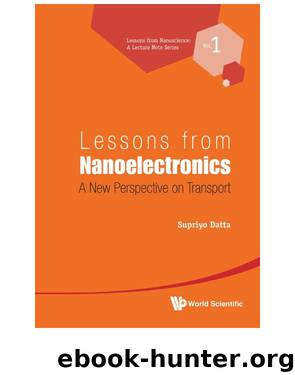Lessons from Nanoelectronics:A New Perspective on Transport: 1 (Lessons from Nanoscience: A Lecture Notes Series) by Supriyo Datta

Author:Supriyo Datta
Language: eng
Format: epub
Publisher: Wspc
Published: 2012-06-29T00:00:00+00:00
Making use of Eq.(16.1b), this implies
The total energy exchanged in the process E1 + E2 + E0 has two parts: One that came from the thermal energy of the surroundings and the other that came from the battery. Eq. (16.3a) tells us that the former must be negative, and Eq.(16.3b) tells us that the latter must be positive. In other words, we can take energy from a battery and dissipate it as heat, but we cannot take heat from the surroundings and charge up our battery.
This should come as no surprise to anybody. After all if we could use heat from our surroundings to charge a battery (perhaps even run a car!) then there would be no energy problem. But the point to note is that this is not prohibited by the first law since energy would still be conserved. It is the second law that makes a distinction between the energy stored in a battery and the thermal energy in our surroundings. The first is easily converted into the second, but not the other way around because thermal energy is distributed among many degrees of freedom. We can take energy from one degree of freedom and distribute it among many degrees of freedom, but we cannot take energy from many degrees of freedom and concentrate it all in one.
This intuitive feeling is quantified and generalized by the second law (Eq.(16.2)) based on solid experimental evidence. For example if we have multiple “contacts” at different temperatures then it is possible to take heat from the hotter contact, dump a part of it in the colder contact, use the difference to charge up a battery and still be compliance with the second law.
Are all the things we have discussed so far in compliance with the second law? The answer is yes. For the elastic resistor E0 = 0, and we can write the second law from Eq.(16.1b) in the form
Download
This site does not store any files on its server. We only index and link to content provided by other sites. Please contact the content providers to delete copyright contents if any and email us, we'll remove relevant links or contents immediately.
| Circuits | Digital Design |
| Electric Machinery & Motors | Electronics |
| Fiber Optics | Networks |
| Superconductivity |
Whiskies Galore by Ian Buxton(41932)
Introduction to Aircraft Design (Cambridge Aerospace Series) by John P. Fielding(33084)
Small Unmanned Fixed-wing Aircraft Design by Andrew J. Keane Andras Sobester James P. Scanlan & András Sóbester & James P. Scanlan(32760)
Craft Beer for the Homebrewer by Michael Agnew(18191)
Turbulence by E. J. Noyes(7974)
The Complete Stick Figure Physics Tutorials by Allen Sarah(7332)
Kaplan MCAT General Chemistry Review by Kaplan(6893)
The Thirst by Nesbo Jo(6871)
Bad Blood by John Carreyrou(6579)
Modelling of Convective Heat and Mass Transfer in Rotating Flows by Igor V. Shevchuk(6405)
Learning SQL by Alan Beaulieu(6233)
Weapons of Math Destruction by Cathy O'Neil(6202)
Man-made Catastrophes and Risk Information Concealment by Dmitry Chernov & Didier Sornette(5950)
Digital Minimalism by Cal Newport;(5695)
Life 3.0: Being Human in the Age of Artificial Intelligence by Tegmark Max(5504)
iGen by Jean M. Twenge(5382)
Secrets of Antigravity Propulsion: Tesla, UFOs, and Classified Aerospace Technology by Ph.D. Paul A. Laviolette(5329)
Design of Trajectory Optimization Approach for Space Maneuver Vehicle Skip Entry Problems by Runqi Chai & Al Savvaris & Antonios Tsourdos & Senchun Chai(5034)
Pale Blue Dot by Carl Sagan(4945)
